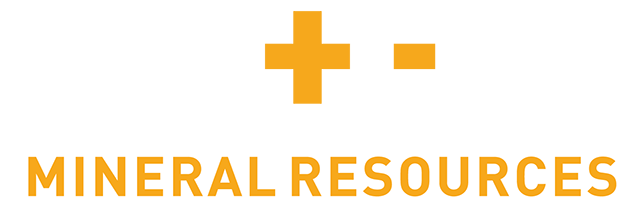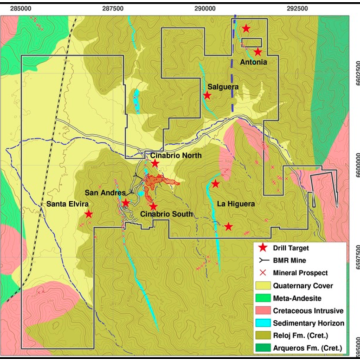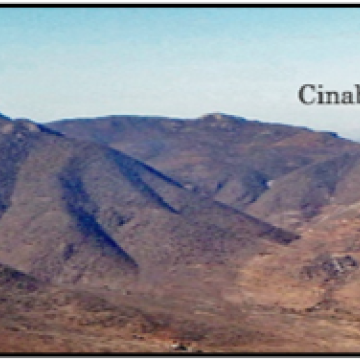Punitaqui Exploration
In March 2021, BMR acquired the Punitaqui copper-gold project in Chile, consists of a centralized process plant fed by four satellite copper deposits. This acquisition was transformative as the mine can be restarted late in 2022 and produce strong cash flow for Battery Mineral Resources.
The Punitaqui Project is a past producing copper-gold mine about 50km south of the Andacollo Copper mine owned by Teck Resources near the town of the towns of Punitaqui and Ovalle in the Fourth Region of the Republic of Chile.
The 8.095-hectare asset consists of a centralized process plant that is fed by four satellite copper deposits - San Andres, Cinabrio, Cinabrio Norte, and Dalmacia.
The Punitaqui project lies within a 25km north-south striking Iron Oxide Copper Gold (IOCG) mineral district that hosts numerous IOCG deposits, mantos and vein style copper occurrence.
The current focus of the Punitaqui exploration team has been the step-out and infill drilling program focused on the San Andres, Dalmacia, Cinabrio Sur and Cinabrio Norte targets.
The Punitaqui project comprises two main blocks; in the north the largest block hosts the Cinabrio Mine and the southern block hosts the Dalmacia Zone.
To date, only limited exploration has been conducted outside the established target zones. These activities include surface prospecting, geological reconnaissance mapping and rock grab sampling.
Two significant targets have been identified in the eastern part of the northern concession block Salguera, and La Higuera. Significant copper oxide mineralization was noted during preliminary reconnaissance work, which is currently being re-examined.
Exploration History
Punitaqui was discovered in 1780 and was exploited by and for the Spanish.
Local small scale artisanal mining occurred sporadically disrupted by long periods of inactivity. Historical records of Punitaqui regional total production and activity are poor.
In general, mining was concentrated at the Los Mantos deposit, by far the largest occurrence of the district. Major periods of activity were 1935 to 1945, especially due to the large demand for mercury during World War II.
Large scale mining halted in 1965 when major floods caused caving of the underground workings. Between 1937 and 1970 Los Mantos produced 350,000 oz Au (470,000 oz Au Eqv.) until 1965. In the surrounding area other veins and mines including Los Mantos, Delirio and Milagros mine (until 1998) reportedly produced 650,000 oz Au Eq.
In the late sixties, CORFO (Chilean Corporacion de Fomento dela Produccion) started open pit mining. In 1982 it was sold to Cerro Centinela Holding Company where plans were started for the construction of a cyanidation plant, mainly for gold recovery of gold in the tailings.
In 1985 the decision was made to reopen on a small scale the Los Mantos mine. About 600 tonnes per month (t/mo) grading 7 to 8 g/t Au were mined by “Pirquineros” and processed in the Ovalle plant.
From 1987 to 1998 a total of 178,290 equivalent ounces of gold were produced. A total of 45,950 were produced by tailings retreatment using cyanidation and 132,340 oz Au Eq were produced by flotation.
From 2007 – 2010, Tamaya Resources Limited, started the mine, undertook a Feasibility Study, and constructed a plant. In 2010, Glencore International Plc acquired the project and upgraded plant & the underground development of Cinabrio. In 2018, Xiana Mining Inc. acquired the mine, increased exploration efforts and initial development of San Andres deposits until it announced a temporary shutdown in 2019.
The mine has been on care and maintenance since April 2020 when the previous operators we’re forced into bankruptcy by its creditors due to the rapid fall in copper prices that were impacted by the COVID-19.
Regionally several locally owned, small scale, surface and underground mines extract both oxide and some sulphide high-grade copper ore which is trucked and sold to a Chilean government operated processing facility.
Geology & Mineralization
The regional geology of Jurassic to lower Cretaceous age consists of a sequence of volcanic rocks (lavas, conglomerates and andesitic breccias) with marine sediment collations (shales, fossiliferous limestones, and thin layers of sandstones). This sequence is affected by a granitic intrusive (Diorites, Granodiorites) of Upper Cretaceous age.
The mantos mineralization at Punitaqui is hosted by a regionally extensive marine sedimentary rock unit within an andesitic volcanic sequence. The sedimentary rock unit is comprised of dark coloured shales, volcanoclastic sandstones, volcanoclastic sedimentary breccias and conglomerates and fossiliferous limestones.
The structural framework of the district is represented by stress and compression forces, this is reflected in a north-south, northwest, and east-west orientation tectonics. The structural fabric of regional and district character control the location of copper mineralization. The sedimentary unit deformed and rotated by extensional faulting resulting in multiple structural repetitions of the mineralized sedimentary unit exposed at surface. The stratigraphy has been consistently rotated to the east resulting in a north-south striking east dipping sequence.
The Punitaqui region hosts Iron Oxide Copper-Gold (IOCG) type mineralization, mantos style copper mineralization and vein hosted copper mineralization. In the northern block mantos style mineralization is the most economically significant. The Cinabrio mine and San Andres target are both Mantos style copper occurrences.
Mineralization is variable and believed to be controlled by mineralizing fluids focused along structures within the footwall rocks. Syngenetic pyrite is a common constituent of the sedimentary unit.
There are three types of wall rock alteration which is sometimes pervasive in the sedimentary sequence.
- Silicification and sericite alteration in San Andres and Upper Cinabrio
- Silicification with potassic alteration including epidote and specularite
- Silicification and sericite alteration with strong tourmaline alteration
In the feeder/stringer zones in the basal andesitic sequence, copper mineralisation comprising mostly bornite is associated with potassic alteration, silicification and occasional epidote. These feeder structures appear to be a structural network that also caused the initial depressions that were filled with the chemically favourable host sequence. They were later reactivated during compression that forced metal bearing fluids into the sequence along these structures.
Current BMR Exploration
The current focus of the Punitaqui Exploration team has been the step-out and infill drilling program focussed on the San Andres, Dalmacia, Cinabrio Sur and Cinabrio Norte targets.
The Punitaqui project comprises two main blocks; in the north the largest block hosts the Cinabrio Mine and the southern block hosts the Dalmacia Zone.
To date, only limited exploration has been conducted outside the established target zones. These activities include surface prospecting, geological reconnaissance mapping and rock grab sampling.
Two significant targets have been identified in the eastern part of the northern concession block Salguera, and La Higuera. Significant copper oxide mineralization was noted during preliminary reconnaissance work.
The outcropping oxide mineralization identified at Salguera and La Higuera is mantos style copper. The copper mineralization s mapped within the Targeted Stratigraphic Unit (“TSU”) which is the same unit that hosts the Cinabrio orebody and the San Andres Target copper mineralization.
At La Higuera the TSU has been traced on surface over a two kilometre north-south strike length. At the Salguera target a similar strike length of outcropping TSU has been identified.
In 2022, BMR intends to complete detailed mapping and systematic rock sampling of both targets to identify drill targets. A preliminary drill test of both targets will follow once access and government permits are finalized.





